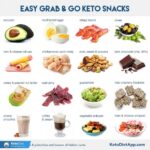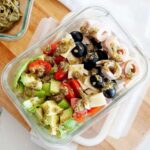Tired of breakfast leaving you sluggish and hungry an hour later? Imagine starting your day with a meal that not only tastes delicious but also provides sustained energy and keeps those hunger pangs at bay. This is the power of high-protein, low-carb breakfasts. We’ll explore a world of flavor and satisfying nutrition, unveiling recipes and strategies to fuel your mornings with lasting fullness and vitality.
This guide delves into the science behind satiety, offering a curated selection of protein-rich foods, delicious recipe ideas, and practical meal-prep strategies. Learn how to balance macronutrients for optimal energy, avoid common pitfalls, and transform your breakfast routine into a powerful tool for achieving your health and wellness goals. Prepare to discover the transformative effect of a well-crafted, high-protein, low-carb breakfast.
Meal Prep Strategies for High-Protein Low-Carb Breakfasts

Planning ahead is key to maintaining a high-protein, low-carb breakfast routine. Consistent preparation ensures you start your day fueled and ready, without resorting to less-than-ideal choices when time is short. This section Artikels three distinct meal prep strategies, each with its own advantages and disadvantages.
Strategy 1: The “Make-Ahead” Method (Batch Cooking)
This strategy involves preparing large batches of breakfast components on the weekend, then assembling individual breakfasts throughout the week. This minimizes daily cooking time.
Schedule: Spend 2-3 hours on Sunday preparing the base components. Assemble individual breakfasts each morning in under 5 minutes.
Ingredients (serves 5): 1.5 lbs ground turkey, 1 large onion (chopped), 2 bell peppers (chopped), 15 eggs, 1 cup spinach, ½ cup shredded cheddar cheese, 1 tbsp olive oil, salt, pepper, your favorite low-carb spices.
- Sunday: Sauté onion and peppers in olive oil. Add ground turkey and cook until browned. Stir in spinach and spices. Divide mixture into 5 equal portions and store in airtight containers in the refrigerator.
- Monday-Friday: In the morning, fry or scramble 3 eggs per serving. Add a portion of the turkey mixture and top with cheese.
Advantages: Significantly reduces weekday morning prep time. Cost-effective due to bulk buying. Allows for creativity with spices and vegetables.
Disadvantages: Requires a large initial time commitment. Requires sufficient refrigerator space. May lead to some food boredom if not varied.
Strategy 2: The “Individual Portion” Method (Freezing)
This method focuses on creating individual, freezer-friendly breakfast portions that can be quickly reheated throughout the week.
Schedule: Dedicate 2-3 hours on a weekend day to prepare and freeze breakfast portions. Reheat in the microwave or oven in the morning.
Ingredients (serves 5): 10 eggs, 5 oz cream cheese, 1 cup cooked bacon (crumbled), ½ cup chopped chives, ½ cup shredded mozzarella cheese, salt, pepper.
- Weekend: Whisk eggs with salt and pepper. Mix in cream cheese until smooth. Stir in bacon and chives. Divide mixture into 5 muffin tins. Top with mozzarella.
- Bake at 350°F (175°C) for 20-25 minutes, or until set. Let cool completely before transferring to freezer bags.
- Monday-Friday: Remove one portion from the freezer the night before. Reheat in the microwave or oven.
Advantages: Excellent for portion control. Convenient for busy mornings. Minimizes food waste as you only reheat what you need.
Disadvantages: Requires freezer space. May require slightly longer reheating time than the “Make-Ahead” method. Initial prep time is similar to the Make-Ahead method.
Strategy 3: The “Quick & Easy” Method (Minimal Prep)
This strategy focuses on simple, readily available ingredients that require minimal preparation time, perfect for those with limited time.
Schedule: Minimal weekend preparation. 5-10 minutes of assembly required each morning.
Ingredients (serves 5): 15 eggs, 5 servings of pre-cooked sausage or bacon, 5 avocados, 5 cups berries (low-sugar varieties).
- Daily: Scramble or fry 3 eggs. Add a serving of pre-cooked sausage or bacon. Serve alongside sliced avocado and a cup of berries.
Advantages: Minimal time commitment. Extremely convenient. Requires minimal cooking skills.
Disadvantages: Can be more expensive than bulk buying ingredients. May require purchasing pre-cooked items, potentially limiting control over ingredients and sodium content. Less variety than other methods.
Embarking on a journey towards a high-protein, low-carb breakfast revolutionizes your mornings, transforming them from a source of fleeting energy into a foundation of sustained vitality. By understanding the interplay of macronutrients, mastering simple meal prep techniques, and exploring the diverse world of protein-rich ingredients, you’ll unlock a breakfast experience that’s both delicious and deeply satisfying. Say goodbye to mid-morning energy crashes and hello to a day fueled by lasting fullness and unwavering focus.
Answers to Common Questions
What are the best low-carb sweeteners to use in these recipes?
Stevia, erythritol, and monk fruit are popular low-carb sweetener options. Consider your personal preferences and any potential digestive sensitivities.
Can I adapt these recipes for a vegan or vegetarian diet?
Many recipes can be adapted! Substitute eggs with tofu or chia seeds for protein, and explore plant-based protein sources like lentils or beans (carefully monitoring carb content).
How long can I store prepared low-carb breakfasts in the refrigerator?
Generally, 3-4 days is a safe timeframe. Always ensure proper refrigeration and observe any signs of spoilage before consumption.
Are there any potential downsides to a high-protein, low-carb breakfast?
While generally healthy, very high protein intake might strain kidneys in some individuals. Ensure adequate hydration and consult a doctor if you have pre-existing conditions.


